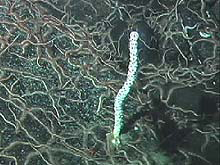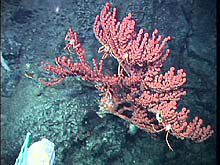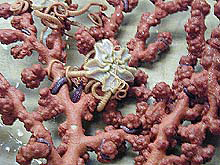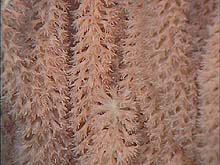
Close up of coral polyps on a bamboo coral. This image was taken during Alvin dive #3800. Click image for larger view.
Cold Corals
July 7, 2002
Amy Baco-Taylor, Postdoctoral Associate
Woods Hole Oceanographic Institute
![]() Watch a video of coral from one of the recent dives. (mp4, 2.9 MB)
Watch a video of coral from one of the recent dives. (mp4, 2.9 MB)
Did you know that corals can live in cold water without any sunlight? If you have viewed other links on this Web site, then you probably already knew that. But did you also know that there are actually more species of scleractinian (stony corals) corals in cold and deep waters than there are in warm tropical waters? Other types of corals are also more diverse in cold/deep waters.
Even in college-level marine biology classes, students are taught that corals live in warm tropical waters and need lots of sunlight to accommodate their symbiotic algae (zooxanthellae). No mention is made of deep water corals or Norwegian coral reefs. Norwegian coral reefs?! That's right. Lophelia pertusa is without symbiotic algae (azooxanthellate), a scleractinian coral that forms extensive reefs in deep water off the coast of Norway and other parts of the world. Lophelia pertusa is just one of many species of deep-water scleractinians. Scleractinian taxonomist Dr. Stephen Cairns of the Smithsonian Institution has shown that there are 656 species of scleractinians with zooxanthellae, (the kind that live in the tropics) and 669 species without zooxanthellae (the kind that live in deep and/or cold water). Undoubtedly, many more of the kinds without zooxanthellae remain to be discovered and described.
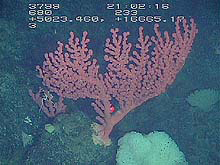
Image of a paragorgia coral or a sea fan, captured during Alvin dive #3799. Click image for larger view.
When is a Tree an Animal?
Did you know that gorgonian corals are often referred to as trees? Coral colonies are made up of large numbers of polyps. Each polyp is similar in appearance to a sea anemone. Together, these polyps form a colony, and colonies make skeletons. These skeletons can take many forms. They can look like a rock or a table, or even a tree! Gorgonian corals (sea fans and sea whips) are most often tree- shaped, with a long stalk like a trunk. The rest of the colony has many branches, like a tree. Some gorgonians grow flat (vertically) which makes them appear almost two-dimensional, and they have branches that resemble fans, hence the name “sea fan.” Others are only a single long piece sticking straight up off the bottom and curling towards the end. These are referred to as “sea whips.” In some areas on seamounts, gorgonian corals are very diverse and abundant. These areas are often referred to as coral “beds.” Diving in a submersible in one of these beds is like being in a miniature forest. Most of the coral trees are a few feet high, and there are all kinds of critters in the branches, swimming, crawling, or walking between the various coral trees. Gorgonian coral trees come in all sizes, from tiny baby trees to ancient trees that are bigger than the submersible!
Corals as a Habitat
Deep-sea gorgonian corals provide habitat for many other creatures, such as the basket starfish and the many polychaetes (the purple slimy worms) wrapped around the coral branches in the photo to the right. Corals add habitat complexity, altering the seafloor by adding a large structure for other organisms to climb up on to reach higher into the water column. Many of these organisms are also suspension feeders like the corals. The higher up they get into the water column, the more food they will find.
We find many invertebrates living on coral trees, including brittle stars, basket stars, crinoids (sea lilies), polychaetes, pinch bugs, sponges and many others. In some larger trees, we often find fish hiding between the branches as well. There may also be animals climbing in the branches that are parasites on the corals, such as some sea stars, sea urchins, and polychaetes. On some gorgonians, the weight from all the animals living on the tree will cause the coral to fall over when the current strengthens. Some kinds of polychaetes burrow into the coral skeletons too, which can weaken the skeleton. Gorgonians lend to the deep sea not only their beauty, but also prime real estate for other marine critters in which to make a home, and perhaps find a meal.
Sign up for the Ocean Explorer E-mail Update List.



























